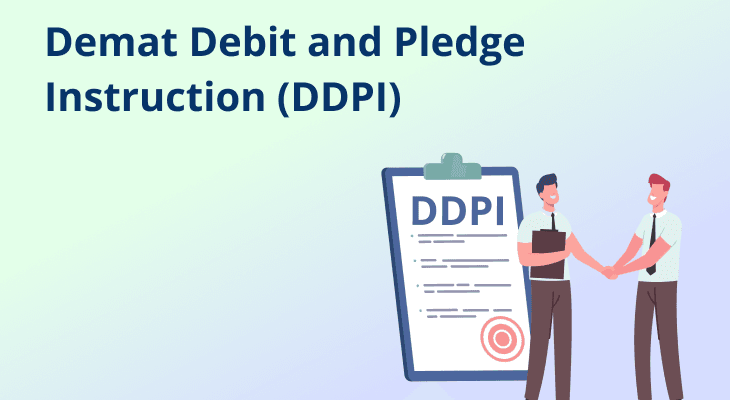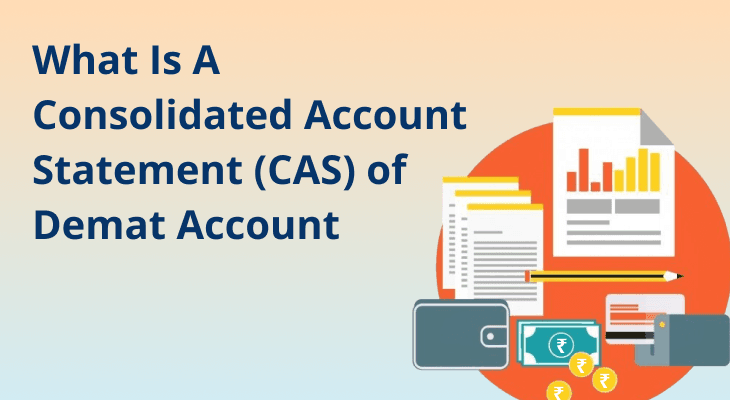
Demat Debit and Pledge Instruction (DDPI): Meaning, Process & Benefits
For years, Power of Attorney (PoA) was the standard document investors signed to give the broker authority to debit shares from their Demat account and execute trades on their behalf. While convenient, PoA raised several concerns around misuse and lack of transparency. There were instances where some brokers misused PoAs, leading to regulatory concerns and investor mistrust.
To resolve these issues and make the process more secure, SEBI introduced Demat Debit and Pledge Instruction (DDPI) in 2022. This move was aimed at improving investor safety while maintaining the ease of transacting. DDPI provides a controlled, transparent way for brokers to debit securities, without the legal overreach of a PoA.
Let’s now understand what exactly DDPI is, how it works, and why activating it is important for any Demat account holder today.
What Is DDPI In Demat Account?
DDPI stands for Demat Debit and Pledge Instruction. It is a regulatory document that lets your broker or Depository Participant (DP) debit securities from your demat account when certain actions, such as sell trades or pledging assets for margin, are taken.
Unlike the older PoA, DDPI comes with tighter compliance, defined scope, and investor-friendly limits. It ensures that your shares can only be debited when there is an actual sell transaction or when you pledge them for margin requirements. This restricts any unauthorised access or movement of your holdings.
Moreover, DDPI must be a separate agreement and can only be used for specific purposes:
- Settling sell orders on the exchange
- Pledging or re-pledging securities for margin
- Executing Transfer of Mutual Fund Units or Open Offer shares via demat
Key Features of DDPI
To understand how DDPI benefits you as an investor, it is important to first grasp its core features:
1. Limited Authorisation: DDPI only allows brokers to debit shares from your Demat account after you have placed a valid sell order. No pre-authorisation or blanket access is granted, unlike PoA.
2. Enables Margin Pledging: If you are an F&O trader or need margin funding, DDPI authorises your broker to pledge your securities to generate margin, without moving the stocks out of your Demat account.
3. No Legal Ownership Transfer: When you use DDPI, your broker doesn’t become the legal owner of your shares. The securities remain in your name, with only limited debit rights granted to the broker.
4. Transaction-specific Usage: Each transaction requires your action. For example, when you sell stocks, the broker can only debit those exact quantities that you sold. It removes blanket access.
5. Optional, Not Mandatory: SEBI has clearly stated that DDPI is not mandatory, but opting in makes trading more seamless without needing OTP-based authorisations for every transaction.
6. Replaces PoA in Most Use-Cases: DDPI serves the same role as PoA such as delivery of shares and pledging for margin, but without the risks of unrestricted access.
7. SEBI-Regulated Document Format: The DDPI format is defined and standardised by SEBI, ensuring that every broker follows the same compliance norms and cannot tweak clauses to suit their own interest.
How Does DDPI Work?
Let’s understand the actual working of DDPI with a few examples.
Example 1: Selling Stocks
Suppose you hold 100 shares of Reliance in your Demat account and want to sell 50.
- You place a sell order via your broker’s trading platform.
- The broker uses DDPI authorisation to debit 50 Reliance shares from your Demat account for settlement.
- The remaining 50 shares remain untouched.
- No extra authorisations like TPIN or OTP are needed.
Example 2: Pledging for Margin
Say you want to trade Nifty options and require margin. You hold 20 HDFC Bank shares.
- You request the broker to pledge those shares.
- With DDPI, the broker can directly place a pledge request with the depository (like CDSL).
- The pledge is reflected on your Demat account, but the shares are still in your name.
- You receive the required margin, and once the position is closed, the pledge is removed.
This process is far smoother than manually generating OTPs or signing forms every time.
Benefits Of Activating DDPI
Here are the major benefits of DDPI for investors:
1. Seamless Selling: You can sell stocks directly from your Demat account without additional steps like e-DIS (electronic delivery instruction slips) or OTPs.
2. Faster Pledging: DDPI helps in pledging securities faster and more efficiently, especially useful for margin trading or short-term derivative positions.
3. Enhanced Security: Brokers can only debit securities post-trade or pledge with your consent. This removes the risk of misuse that existed under PoA.
4. No Need for TPINs: Avoid multiple OTPs or CDSL TPINs for every transaction, saving time and making trading smoother.
5. No Legal Hassles: Unlike PoA, DDPI is not a power of attorney in the legal sense. It reduces legal complications and brings more clarity.
Additional Read: How to Generate CDSL TPIN
Is DDPI Mandatory for All Investors?
No, DDPI is not mandatory. However, most brokers, including m.Stock, highly recommend it for regular investors and traders to simplify their trading experience.
If you do not activate DDPI, you can still place delivery trades using OTP-based authorisation (TPIN) for each transaction. But this process may slow down your transactions, especially in fast-moving markets.
Common Myths About DDPI
Let’s bust some myths:
- Myth 1: DDPI gives brokers unlimited access to my account.
Fact: No. Brokers can only debit shares for trades you have placed or when pledging is initiated by you. - Myth 2: It’s mandatory to activate DDPI to trade.
Fact: It is optional. You can still trade using TPIN-based authorisation. - Myth 3: DDPI means giving up control of my Demat account.
Fact: You retain full ownership. DDPI only gives conditional, transaction-specific access.
How To Enable DDPI In m.Stock Demat Account?
m.Stock offers a simple and secure way to activate DDPI online.
Step 1: Log in to your m.Stock app or web dashboard.
Step 2: Go to Profile > DDPI Activation.
Step 3: Accept the terms and digitally sign the document via Aadhaar-linked eSign.
Step 4: You’ll receive confirmation once your DDPI is activated, usually within 24–48 hours.
You can now enjoy smooth delivery trading and margin pledging without TPIN interruptions.
Conclusion
The Demat Debit and Pledge Instruction (DDPI) is a game-changer for investors and traders who value speed, safety, and simplicity. It replaces the outdated and risky Power of Attorney system with a transparent, SEBI-regulated framework that protects your securities while offering operational ease.
For investors using m.Stock, activating DDPI is highly recommended to make the most of your trading experience without compromising control or safety. Whether you’re a casual investor or a regular trader, DDPI brings the right balance of efficiency and compliance.
Additional Read: Features & Benefits of a Demat Account - Demat A/C Advantages
Additional Read: What is Demat Account: Aims, Objectives, & Significance
FAQ
What is DDPI in a Demat account?
DDPI stands for Demat Debit and Pledge Instruction. It is a legal document that authorises your broker to debit securities from your Demat account for sell trades and to pledge securities for margin without needing repeated OTP-based approvals.
How is DDPI different from PoA?
Unlike Power of Attorney (PoA), which grants blanket access to your account, DDPI limits the broker’s authority to specific transactions only. It is more secure, regulated, and investor-friendly, with no transfer of legal ownership of securities.
Is DDPI mandatory for stock trading?
No, DDPI is not mandatory. You can continue trading using CDSL TPIN or e-DIS methods. However, enabling DDPI makes the process smoother and more efficient, especially for regular traders or margin users.
Can I sell shares without DDPI?
Yes, but you will need to authorise each transaction using a TPIN and OTP, which can slow down the trade execution process and lead to lost opportunities. With DDPI, this step is bypassed, enabling quicker trade settlements.
Is DDPI safe for my Demat holdings?
Yes, DDPI is designed with security in mind. It only allows conditional access to debit or pledge securities after you place a trade or initiate a pledge request. The broker cannot access your holdings freely, keeping them intact until you choose to trade them.
What happens if I don’t enable DDPI?
You can still trade, but all sell orders and pledging actions will require additional steps like OTPs, TPINs, or manual e-signs. It might be less convenient compared to DDPI-enabled trading. It can also lead to loss of opportunities due to the delays these manual actions can cause.
How long does it take to activate DDPI in m.Stock?
DDPI activation typically takes 24 to 48 hours after you submit your Aadhaar-based eSign. m.Stock notifies you once the process is completed, and you can start trading seamlessly. You can always contact our customer care to know more about the process and the status of your application.
Does DDPI allow margin trading?
Yes. With DDPI, your broker can pledge approved securities from your Demat account to provide you with margin for F&O or intraday trades without needing to transfer ownership of the securities.
Can I revoke DDPI later?
Yes, you can revoke DDPI at any time by submitting a written request to your broker. Once revoked, you’ll go back to the manual authorisation process (using TPIN or OTP).
Is there any charge for enabling DDPI?
In most cases, enabling DDPI is free of charge. Platforms like m.Stock allow you to activate it digitally without any paperwork or fees.


